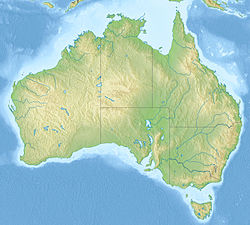Murchison Widefield Array

An individual MWA-32T tile
|
|
| Location(s) |
Murchison Radio-astronomy Observatory |
|---|---|
| Coordinates | 26°42′12″S 116°40′16″E / 26.7033°S 116.671°ECoordinates: 26°42′12″S 116°40′16″E / 26.7033°S 116.671°E |
| Wavelength | 3.75, 1 m (80, 300 MHz) |
| Built | 2007–2012 |
| Telescope style |
radio interferometer |
| Diameter | 3 km (9,842 ft 6 in) |
| Collecting area | 512 m2 (5,510 sq ft) |
| Website | www |
|
|
|
|
[]
|
|
The Murchison Widefield Array (MWA) is a joint project between an international consortium of universities to build a low-frequency radio array operating in the frequency range 80–300 MHz. The main scientific goals of the MWA are to detect neutral atomic Hydrogen emission from the cosmological Epoch of Reionization (EoR), to study the sun, the heliosphere, the Earth's ionosphere, and to study radio transient phenomena. The total cost of the project is A$51 million.
The MWA is the first so-called large-N array, fully cross-correlating signals from 128 phased tiles, each of which consist of 16 crossed dipoles arranged in a 4x4 square. The field of view is large by the standard of astronomical instruments, being on the order of 30 degrees across.
The MWA was to be situated at Mileura Station where initial testing had been conducted then moved southwest to Boolardy station in outback Western Australia, at the Murchison Radio-astronomy Observatory (MRO), 800 kilometres north of Perth. This location offers a quiet radio environment and stable climate for observations. The MRO is also the site of CSIRO's Australian Square Kilometre Array Pathfinder (ASKAP) and one of two selected sites for the Square Kilometre Array (SKA). In addition to the geographic link, the MWA is a technology and science pathfinder for the SKA.
The MWA is an inherently versatile instrument with a wide range of potential science goals. Scientific priorities during the early science phase will be determined partly by the evolving instrumental capabilities, and partly by the potential of such studies to accelerate commissioning and the initiation of the key science projects.
In astronomy, the highest priority key science project is detection of red-shifted 21 cm signals from HI during the EoR, using power spectral techniques, direct detection of quasar ionised "bubbles", or both. The MWA will be one of the most sensitive EoR instruments yet constructed: its observations should characterise the properties of the sources that are responsible for ionizing the intergalactic medium, chart the evolution of the global neutral fraction, and probe the nature of quasar emissions by constraining the properties of their ionized proximity zones.
...
Wikipedia

